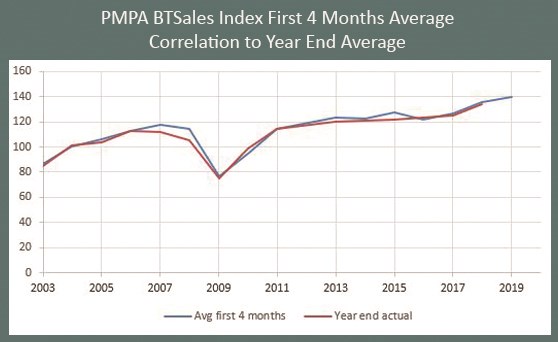If You Had Only One Number
You know your sales number, but do you know what it means?
Running a precision machining business means seeing many numbers each day. This includes production, sales, revenue, shipments, rejections, costs, hours worked, hours earned, uptime and downtime. I could fill this entire page with numbers we are required to deal with each and every day.
But what numbers from the outside world can you use to help make sense of all of your numbers? What number do you lack, that you might better understand the numbers that you generate? At PMPA, our members gain monthly insight into the market, their peers, and a glimpse of their standing by participating in PMPA’s monthly Business Trends Report. The Sales Index, in particular, gives them a multidimensional measure by which to understand the market, the performance of their peers and their standing in relation to both the market and their peers. The PMPA Business Trends Sales Index also has a predictive aspect, as some shops have identified that their performances leads, or lags, the monthly index. And the PMPA Monthly Business Trends Index gives a strong prediction to where sales for the industry will come.
The PMPA Business Trends Report is built with submissions from our member shops with just six numbers. Sales dollars and hours of first shift scheduled are actual values reported each month and submitted confidentially via a secure website. The remaining four values are sentiment indicators and ask the participating shop for their outlook for the next three months for sales, profitability, lead time and employment. Each of these is ranked as either up, down or remains the same.
The report calculates the sales index of the responding shops, comparing it with past levels, and creates an aggregate for all reporting shops. The average hours of first shift scheduled is aggregated and reported for the present month.

The sentiment indicators are also classified into the number and percentage of shops reporting up, down or remaining the same. The indicators are then graphed to show the trend. The sentiment indicators are graphed two ways: the aggregate compared with prior months and by showing both the trend line and the underlying distribution of members reporting in each up, down or remained-the-same category.
From the sales number, the Business Trends Report allows you to compare it with prior values for the year to date, as well as the past few years, and compares the current month and year-to-date average to prior values.
If your sales are up, is it because you had a great sales month, because the entire industry had a great sales month or are they in fact underperforming the sales of your peers? How do you know? Our shops have been consistently outperforming the Fed’s Industrial Production indicator for some time, so that is not a good benchmark. How can you calibrate?
What gives you confidence and assurance to make business decisions? One of the more powerful aspects of the PMPA Business Trends Report Sales Index is its power to predict sales for the balance of the year. The sentiment indicator asks about sales outlook for the next three months, and you can use that as a short-term benchmark. But the PMPA Sales Index average of the first four months of the year has a remarkable correlation to the end-of-year sales index. Last year it was off by only 0.7%. The four-month average has been shown to explain (by correlation statistics) more than 96% of the change in the end-of-year sales number. See the graph above.
What one number or one single report do you have that provides you such clarity and insight into your own shop’s performance? PMPA members have monthly access to the Business Trends Report, as well as personal reports of their own shop that let them calibrate their outlook to that of 80 or more of their peers. That predicts, with remarkable statistical confidence, expected sales levels for the end of the year, as well as shared sentiment indicators on sales, lead time and profitability and employment outlook for the next three months.
So how are your sales? Yes, you know your number, but do you know what it means?
Related Content
Craftsman Cribsheet No. 126: AISI System of Identification
Source: PMPA Prior to the Society of Automotive Engineers taking responsibility for Steel Grade nomenclature in the United States (1995), the American Iron and Steel Institute determined U.S. standard steel grades in collaboration with SAE.
Read MoreA No/Low-Cost Solution to Employee Retention
Studies show a little employee recognition goes a long way. Here are the 5Ws to consider for success.
Read MoreCraftsman Cribsheet No. 119: Defeating the Hanging Cross-Hole Burr
Deburring is a tedious task that is better left to machines.
Read MoreCraftsman Cribsheet No. 129: How to Beat the Heat
Shops tend to heat up in the summer. Here are some tips for staying cool in the warmer months.
Read MoreRead Next
5 Aspects of PMTS I Appreciate
The three-day edition of the 2025 Precision Machining Technology Show kicks off at the start of April. I’ll be there, and here are some reasons why.
Read MoreDo You Have Single Points of Failure?
Plans need to be in place before a catastrophic event occurs.
Read MoreA Tooling Workshop Worth a Visit
Marubeni Citizen-Cincom’s tooling and accessory workshop offers a chance to learn more about ancillary devices that can boost machining efficiency and capability.
Read More





















